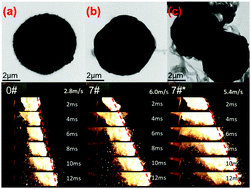Study on the preparation parameters and combustion performance of Al/PTFE composites prepared by a mechanical activation-sintering method
Abstract
Aluminum (Al) is widely used to improve the combustion performance of energetic material formulations. However, only a limited part of the energy released by the oxidation of aluminum works because of ignition delay and incomplete combustion. In order to overcome this defect, a mechanical activation-sintering method is developed to prepare Al/PTFE composites for enhancing the combustion performance of Al powders. Scanning electron microscopy (SEM) and X-ray diffraction (XRD) are used to analyze the morphology and structures of the samples. An orthogonal experiment is employed to filter the best preparation parameters by evaluating the combustion pressure in a closed vessel. With the conditions of 65 : 35 (g/g, mass ratio of Al and PTFE), 12 : 1 (g/g, ball-to-powder weight ratio, BPR), 250 rpm (rotation speed of ball milling container) and 45 min (milling duration), the Al powders are coated uniformly by PTFE and the composites exhibit excellent dispersity. By optimizing the preparation conditions, the maximum pressure, pressurization rate as well as the flame propagation are highly improved, compared to that of a simple mixture of Al powders and PTFE. This work provides a feasible and universal method to prepare aluminum-containing composites.



 Please wait while we load your content...
Please wait while we load your content...